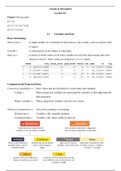Zusammenfassung
Summary Lecture 01: Visuals & Descriptive [Week 6]
- Kurs
- Hochschule
- Book
An extensive summary of chapters 2, 3, and 4. Learning material is further clarified with the help of images and symbols to better visualize and understand the learning material.
[ Mehr anzeigen ]




